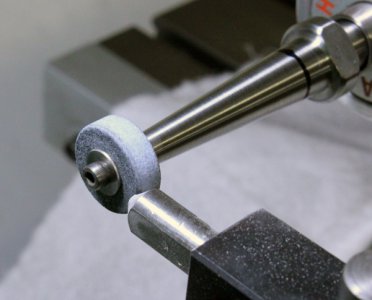I don't have a lot of run time or experience on my TPG but I'm finishing these cast iron liners which are 0.945" bore x 1.8" long. I've dressed the wheel in-situ. I think its 100 grit but would have to confirm. About 0.75" diameter x 1/4" thick. Its removing material nicely. I rough at 0.0005" DOC (0.001" diameter) and finish at about half that. I'm spinning the grinding wheel at manufacturer recommended rpm for wheel diameter. Lathe is spinning at 300 rpm, direction is reverse to grinder wheel direction. The bore diameters are within 0.0001-0.0002 end for end. So dimensionaly everything seems fine. These need to be lapped anyways so I'm stopping about 0.0005" diameter undersize.
The only thing I'm wondering about is what looks like a pattern inside the bore and lack of shiny finish. It looks worse than it is & hard to photo properly, but hopefully you can see in the pics with the part in the lathe. When I lap with 800 grit (holding up to light pics) no grinder marks are seen. It becomes a constant mat finish in a very short time. But just to show the contrast, the OD was done with no TPG, just basic backed sanding blocks up to about 1200 paper. It looks much shinier. I re-dressed a few times, tried rounding over the edges. Those ones looked a bit better than these pics but generally similar.
I've seen pictures of TPG results that are very shiny but mostly on steels, tool steels, chrome plated bores etc. Even with coarser wheels. Is cast iron different in this regard where its duller or can you spot something I'm not doing right?
The only thing I'm wondering about is what looks like a pattern inside the bore and lack of shiny finish. It looks worse than it is & hard to photo properly, but hopefully you can see in the pics with the part in the lathe. When I lap with 800 grit (holding up to light pics) no grinder marks are seen. It becomes a constant mat finish in a very short time. But just to show the contrast, the OD was done with no TPG, just basic backed sanding blocks up to about 1200 paper. It looks much shinier. I re-dressed a few times, tried rounding over the edges. Those ones looked a bit better than these pics but generally similar.
I've seen pictures of TPG results that are very shiny but mostly on steels, tool steels, chrome plated bores etc. Even with coarser wheels. Is cast iron different in this regard where its duller or can you spot something I'm not doing right?










